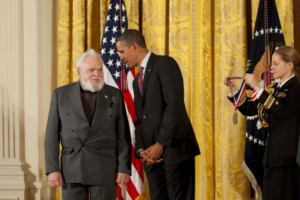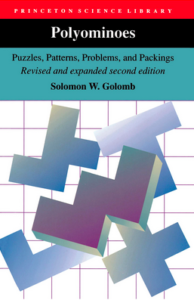LA JOLLA, California — Dr. Beatrice Golomb, head of the UC San Diego Golomb Research Group, describes her father as “far and away the smartest person anyone who knew him had ever met.”

That statement might sound like hyperbole until you learn more about the late Professor Solomon Golomb, a Harvard University-educated mathematician known as the father of modern digital technologies, due to his ability to apply advanced mathematics to problems in digital communications. A recipient of prestigious awards such as the National Medal of Science and the Benjamin Franklin Medal in Electrical Engineering, he is also partially credited with the creation of the game Tetris.
The Jerusalem College of Technology (JCT) recently hosted Dr. Sabine Segre of Achva Academic College, who delivered “The Spectrum of Tetris: From Dominoes to Tetrominoes and Beyond,” this year’s Annual Golomb Lecture. The lecture — dedicated to the memory of Reb Yehuda Leib, Rav Elhanan, and Solomon Golomb — was a nod to Polyominoes, a field of math developed by Solomon centered around the shapes formed by connecting unit squares edge-to-edge.
As Solomon Golomb explained in the IEEE Transactions on Information Theory journal, “I generalized a puzzle problem about putting dominoes on a checkerboard from which a pair of opposite corners had been removed, and created the subject of Polyominoes.” He later wrote the book Polyominoes: Puzzles, Patterns, Problems, and Packings. He continued, “A young Russian, A. Pazhitnov, reading the Russian translation of Polyominoes, was inspired, using my ‘tetromino’ shapes, to invent the computer game Tetris. More people have heard of me from polyominoes than from anything else I have done.”

According to Beatrice Golomb, Solomon first learned about JCT from Steve Schloss, one of his former graduate students. JCT’s institutional mission resonated with Solomon because he “felt strongly about the importance of providing avenues to integrate the ultra-Orthodox in Israel into society,” and admired the college’s ability “to help individuals in that community to not just survive but thrive” and to contribute to advancements in Israel’s technology-related fields.
Solomon initially made a donation to JCT to hold an annual lecture in memory of his father, Rav Elhanan, whom Beatrice called “both an incredible secular scholar and scholar of Judaism.” Solomon died in 2016, and Beatrice later reinaugurated the donation to JCT. Last year, the lecture series was revived, and expanded to also honor Solomon’s memory.
“It seemed like the right thing to continue his effort to honor his father,” Beatrice said.
Beatrice wrote regarding her father in IEEE Transactions on Information Theory, “Sol’s fund of knowledge was ever prodigious. He used to joke (not really joking) that he could give a half hour lecture on any subject whatsoever. (This was long before internet and Wikipedia made it easy to find information.) And it wasn’t just that he seemed somehow to know everything; his brain reformulated, organized, and understood it — with his massive knowledge base and powers of reasoning and synthesis to draw on — in a way not elsewhere to be found. I recall, as one exemplar, when an engineering colleague lamented to Sol that he had been roped into serving on a panel on jurisprudence, a subject about which he knew nothing. Sol proceeded (in illustration of his claim) to sit the colleague down, and deliver a half hour disquisition on jurisprudence. After the friend participated in the panel, he triumphantly told Sol that — thanks purely to Sol’s tuition — he had known more about jurisprudence than any on the panel, including judges.”
Solomon’s digital communications algorithms, she said, are considered the most-used algorithms in history — with 1 octillion uses.
“One of his gifts was seeing how this mathematics actually applied to real-world problems — recognizing one thing that didn’t have an obvious relationship to the other,” she said, adding, “He had this gift of recognizing when mathematical things and physical things bore an interrelation, and this enabled him to make many of the advances that he made.”
Today, Beatrice’s Golomb Research Group studies different conditions related to oxidative stress and cell energy impairments. The group is currently working with Gulf War veterans and people who have suffered adverse events while taking statin cholesterol medications or fluoroquinolone antibiotics. Beatrice is also a professor of medicine at UC San Diego.
She actually had not known about JCT’s Annual Golomb Lecture until accompanying her father on a visit to Israel. She praised the college’s work to shatter stereotypes surrounding women’s lagging interest in science and technology careers, through offering academic programs specifically geared towards creating opportunities for women. Fifty-three percent of JCT’s computer science students are women, accounting for 20 percent of female computer science students in all of Israel.
Beatrice said her father had emphasized that “women, given comparable attention and opportunities, could excel fully as well” in any profession.
This year’s Annual Golomb Lecture was held shortly after JCT President Professor Chaim Sukenik visited San Diego, where he delivered two community presentations — “The Interface Between Halacha and Modern Technology” on June 21 at Congregation Adat Yeshurun and “A Scientist’s Perspective on Judaism and Torah Learning” on June 22 at Beth Jacob Congregation.
*
Preceding provided by the Jerusalem College of Technology